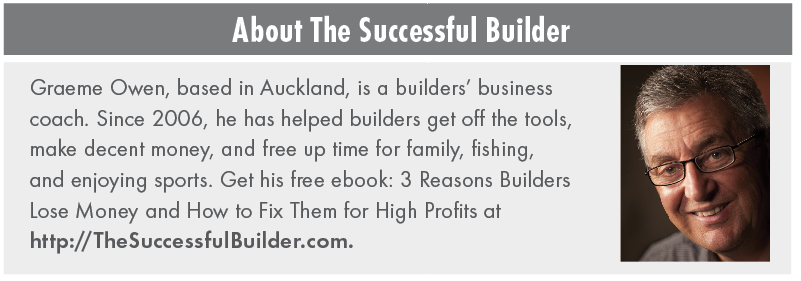Creating accurate quotes
10 Nov 2015, Builders business, Business Tips, Featured, Prove Your Know How

A recent research exercise revealed that one of the three biggest challenges facing builders is quoting residential work correctly. Here are several tips to help you get them right
Quoting accurately can be especially challenging for builders who have recently started their own business. Common questions include:
- How do I quote correctly?
- How do I make sure that I am not going to exceed budget?
- How can I ensure that I charge a fair price and make money?
Of course, a straightforward new home is reasonably easy to quote. The only real variable you have as a builder is the carpentry time. However, renovations, larger builds and architecturally designed homes can be quite a different story. Unique details and structural particulars can catch you out.
I am sure that you know of many cases (as I do) where a builder has underestimated the time a job has taken and lost money.
Unfortunately, there is not one solution to the problem of an incorrect quote. There are simply too many variables to consider, such as the fitness of the members of your team and how fast they work; the skill levels of your builders; the ability of your foreman to plan ahead; the scheduling of subcontractors; rework; wastage of materials etc. to say nothing of unexpected problems or weather interruptions.
Here are several things about quoting that I’ve learned:
1. Know your limits
Some builders are good at maths and love designing spreadsheets for their business, others aren’t. If you struggle with spreadsheets, then be very careful about creating your own to compile quotes. It’s so easy to make a formula error that can cost you heaps. It is also easy to confuse mark-ups, margins, charge out rates, preliminary and general, and profit percentages. What may look like a good quote that wins you the job can in fact have a negative impact on your business.
It is better to invest in a good piece of quoting/estimating software and take the time to learn how to use it well.
2. Know when to estimate
Just because a client asks for a quote on a renovation, or a complicated build, doesn’t mean you have to give them a fixed-price quote. It may be better to give them an estimate of overall cost and then quote your rates.
This is especially true if you are not experienced in such jobs. In that case, you are probably better to spend your time showing your client why an estimate with quoted rates is a better option for them.
3. Highlight uncertain areas
Sometimes there are parts of a job that you are unable to quote accurately. It may be that you simply don’t have the expertise, or that there are too many variables.
Should this be the case, then don’t be afraid to separate the uncertain parts from the fixed part of your quote. Give those uncertain parts a rough estimate (if you can), but make sure that your client understands which is which.
4. Use a quantity surveyor
There is no argument that correct quantities are important for developing accurate quotes – that and spot on labour forecasting. You can ensure that you have accurate quantities by paying for a professional quantity surveyor to help on your jobs.
Instead of labouring over numbers and quantities you’re not sure are right, spend the time more profitably improving the other components of a great quote. For example, reviewing the plans and coming up with the best build processes so you can reassure the client you really are the best choice of builder.
Also, as a result of pouring over the plans, you may well be better equipped to assess whether or not your team can complete the job in the hours the QS has estimated. Or, whether you need to allow more time because of the complexity of certain construction details you suspect will take your team longer.
5. Back cost previous jobs
Henry Ford said, “history is bunk,” but a contemporary of his also said, “those who cannot remember the past are condemned to repeat it” (George Santayana).
And how true this is in a building business. For example, the builder who heads straight into the next job without back-costing the previous one is highly likely to repeat any mistakes in the new job.
Back costing is the only way to get real information about the performance of yourself and your team. If you estimated 500 hours for a job and it actually took you 650, then next time around you should allow 650. You would adjust your estimating formulae.
It sounds like common sense, but I have met builders who keep estimating with the same formulae – after they have lost money! They then wonder why they are not making a profit.
While it may be time consuming, it’s worth the effort to back cost every quoted and estimated job. By doing so, you build up a record of your team’s performance so you can estimate jobs more accurately in the future.
Getting your quoting right is really important in building a long-term secure business. So make sure that you don’t leap into giving quotes just to stay in the game. Doing so may put you out!
Register to earn LBP Points Sign in



